Neutron Diffraction and Diffraction Contrast Imaging for Mapping the TRIP Effect under Load Path Change
Abstract
1. Introduction
2. Materials and Methods
3. Results
4. Discussion and Prospects of the Method
5. Conclusions
Author Contributions
Funding
Conflicts of Interest
References
- Allain, S.; Chateau, J.-P.; Bouaziz, O.; Migot, S.; Guelton, N. Correlations between the calculated stacking fault energy and the plasticity mechanisms in Fe–Mn–C alloys. Mater. Sci. Eng. A 2004, 387–389, 158–162. [Google Scholar] [CrossRef]
- Martin, S.; Wolf, S.; Martin, U.; Krüger, L.; Rafaja, D. Deformation Mechanisms in Austenitic TRIP/TWIP Steel as a Function of Temperature. Met. Mater. Trans. A 2016, 47, 49–58. [Google Scholar] [CrossRef]
- Behjati, P.; Najafizadeh, A. Role of Chemical Driving Force in Martensitic Transformations of High-Purity Fe-Cr-Ni Alloys. Met. Mater. Trans. A 2011, 42, 3752. [Google Scholar] [CrossRef]
- Olson, G.B.; Cohen, M. Kinetics of strain-induced martensitic nucleation. Met. Mater. Trans. A 1975, 6, 791. [Google Scholar] [CrossRef]
- Shen, Y.F.; Li, X.X.; Sun, X.; Wang, Y.D.; Zuo, L. Twinning and martensite in a 304 austenitic stainless steel. Mater. Sci. Eng. A 2012, 552, 514–522. [Google Scholar] [CrossRef]
- Di Gioacchino, F.; Quinta da Fonseca, J. An experimental study of the polycrystalline plasticity of austenitic stainless steel. Int. J. Plast. 2015, 74, 92–109. [Google Scholar] [CrossRef]
- Das, Y.B.; Forsey, A.N.; Simm, T.H.; Perkins, K.M.; Fitzpatrick, M.E.; Gungor, S.; Moat, R.J. In situ observation of strain and phase transformation in plastically deformed 301 austenitic stainless steel. Mater. Des. 2016, 112, 107–116. [Google Scholar] [CrossRef]
- Wang, H.; Jeong, Y.; Clausen, B.; Liu, Y.; McCabe, R.J.; Barlat, F.; Tomé, C.N. Effect of martensitic phase transformation on the behavior of 304 austenitic stainless steel under tension. Mater. Sci. Eng. A 2016, 649, 174–183. [Google Scholar] [CrossRef]
- Martin, S.; Ullrich, C.; Rafaja, D. Deformation of Austenitic CrMnNi TRIP/TWIP Steels: Nature and Role of the ε–martensite. Mater. Today Proc. 2015, 2, S643–S646. [Google Scholar] [CrossRef]
- Martin, S.; Ullrich, C.; Šimek, D.; Martin, U.; Rafaja, D. Stacking fault model of ∊-martensite and its DIFFaX implementation. J. Appl. Crystallogr. 2011, 44, 779–787. [Google Scholar] [CrossRef]
- Gu, J.; Zhang, L.; Ni, S.; Song, M. Effects of grain size on the microstructures and mechanical properties of 304 austenitic steel processed by torsional deformation. Micron 2018, 105, 93–97. [Google Scholar] [CrossRef] [PubMed]
- Caër, C.; Pesci, R. Local behavior of an AISI 304 stainless steel submitted to in situ biaxial loading in SEM. Mater. Sci. Eng. A 2017, 690, 44–51. [Google Scholar] [CrossRef]
- Polatidis, E.; Hsu, W.-N.; Šmíd, M.; Panzner, T.; Chakrabarty, S.; Pant, P.; Van Swygenhoven, H. Suppressed martensitic transformation under biaxial loading in low stacking fault energy metastable austenitic steels. Scr. Mater. 2018, 147, 27–32. [Google Scholar] [CrossRef]
- Polatidis, E.; Šmíd, M.; Hsu, W.-N.; Kubenova, M.; Capek, J.; Panzner, T.; Van Swygenhoven, H. The interplay between deformation mechanisms in austenitic 304 steel during uniaxial and equibiaxial loading. Mater. Sci. Eng. A 2019, 764, 138222. [Google Scholar] [CrossRef]
- Repper, J.; Niffenegger, M.; van Petegem, S.; Wagner, W.; van Swygenhoven, H. In Situ Biaxial Mechanical Testing at the Neutron Time-of-Flight Diffractometer POLDI. Available online: https://www.scientific.net/MSF.768-769.60 (accessed on 1 April 2019).
- Collins, D.M.; Mostafavi, M.; Todd, R.I.; Connolley, T.; Wilkinson, A.J. A synchrotron X-ray diffraction study of in situ biaxial deformation. Acta Mater. 2015, 90, 46–58. [Google Scholar] [CrossRef]
- Kiriyama, K.; Zhang, S.; Hayashida, H.; Suzuki, J.; Kuwabara, T. Development of a biaxial tensile testing machine for pulsed neutron experiments. MethodsX 2019, 6, 2166–2175. [Google Scholar] [CrossRef]
- Hommer, G.M.; Park, J.-S.; Brunson, Z.D.; Dahal, J.; Kenesei, P.; Mashayekhi, A.; Almer, J.D.; Vignes, J.; Lemmer, S.R.; Clausen, B.; et al. A Planar Biaxial Experiment Platform for In Situ High-Energy Diffraction Studies. Exp. Mech. 2019, 59, 749–774. [Google Scholar] [CrossRef]
- Collins, D.M.; Erinosho, T.; Dunne, F.P.E.; Todd, R.I.; Connolley, T.; Mostafavi, M.; Kupfer, H.; Wilkinson, A.J. A synchrotron X-ray diffraction study of non-proportional strain-path effects. Acta Mater. 2017, 124, 290–304. [Google Scholar] [CrossRef]
- Hsu, W.-N.; Polatidis, E.; Šmíd, M.; Casati, N.; Van Petegem, S.; Van Swygenhoven, H. Load path change on superelastic NiTi alloys: In situ synchrotron XRD and SEM DIC. Acta Mater. 2018, 144, 874–883. [Google Scholar] [CrossRef]
- Hsu, W.-N.; Polatidis, E.; Šmíd, M.; Van Petegem, S.; Casati, N.; Van Swygenhoven, H. Deformation and degradation of superelastic NiTi under multiaxial loading. Acta Mater. 2019, 167, 149–158. [Google Scholar] [CrossRef]
- Van Petegem, S.; Wagner, J.; Panzner, T.; Upadhyay, M.V.; Trang, T.T.T.; Van Swygenhoven, H. In-situ neutron diffraction during biaxial deformation. Acta Mater. 2016, 105, 404–416. [Google Scholar] [CrossRef]
- Sofinowski, K.; Panzner, T.; Kubenova, M.; Čapek, J.; Van Petegem, S.; Van Swygenhoven, H. In situ tension-tension strain path changes of cold-rolled Mg AZ31B. Acta Mater. 2019, 164, 135–152. [Google Scholar] [CrossRef]
- Polatidis, E.; Hsu, W.-N.; Šmíd, M.; Van Swygenhoven, H. A High Resolution Digital Image Correlation Study under Multiaxial Loading. Exp. Mech. 2019, 59, 309–317. [Google Scholar] [CrossRef]
- Upadhyay, M.V.; Panzner, T.; Van Petegem, S.; Van Swygenhoven, H. Stresses and Strains in Cruciform Samples Deformed in Tension. Exp. Mech. 2017, 57, 905–920. [Google Scholar] [CrossRef] [PubMed]
- Stuhr, U.; Grosse, M.; Wagner, W. The TOF-strain scanner POLDI with multiple frame overlap—Concept and performance. Mater. Sci. Eng. A 2006, 437, 134–138. [Google Scholar] [CrossRef]
- Upadhyay, M.V.; Capek, J.; Panzner, T.; Van Swygenhoven, H. Microstructure evolution of stainless steel subjected to biaxial load path changes: In-situ neutron diffraction and multi-scale modeling. Int. J. Plast. 2019, 122, 49–72. [Google Scholar] [CrossRef]
- Olson, G.B.; Cohen, M. A general mechanism of martensitic nucleation: Part I. General concepts and the FCC→HCP transformation. MTA 1976, 7, 1897–1904. [Google Scholar]
- Upadhyay, M.V.; Patra, A.; Wen, W.; Panzner, T.; Van Petegem, S.; Tomé, C.N.; Lebensohn, R.A.; Van Swygenhoven, H. Mechanical response of stainless steel subjected to biaxial load path changes: Cruciform experiments and multi-scale modeling. Int. J. Plast. 2018, 108, 144–168. [Google Scholar] [CrossRef]
- Hewat, A.W. High flux diffractometers on reactor neutron sources. Phys. B Condens. Matter 2006, 385–386, 979–984. [Google Scholar] [CrossRef]
- Willis, B.T.M.; Willis, B.T.M.; Carlile, C.J. Experimental Neutron Scattering; Oxford University Press: Oxford, UK, 2009; ISBN 978-0-19-851970-6. [Google Scholar]
- Santisteban, J.R.; Edwards, L.; Fitzpatrick, M.E.; Steuwer, A.; Withers, P.J.; Daymond, M.R.; Johnson, M.W.; Rhodes, N.; Schooneveld, E.M. Strain imaging by Bragg edge neutron transmission. Nucl. Instrum. Methods Phys. Res. Sect. A Accel. Spectrometers Detect. Assoc. Equip. 2002, 481, 765–768. [Google Scholar] [CrossRef]
- Steuwer, A.; Santisteban, J.R.; Withers, P.J.; Edwards, L. Pattern decomposition and quantitative-phase analysis in pulsed neutron transmission. Phys. B Condens. Matter 2004, 350, 159–161. [Google Scholar] [CrossRef]
- Woracek, R.; Penumadu, D.; Kardjilov, N.; Hilger, A.; Boin, M.; Banhart, J.; Manke, I. 3D Mapping of Crystallographic Phase Distribution using Energy-Selective Neutron Tomography. Adv. Mater. 2014, 26, 4069–4073. [Google Scholar] [CrossRef] [PubMed]
- Makowska, M.G.; Strobl, M.; Lauridsen, E.M.; Frandsen, H.L.; Tremsin, A.S.; Kardjilov, N.; Manke, I.; Kelleher, J.F.; Theil Kuhn, L. Effect of stress on NiO reduction in solid oxide fuel cells: A new application of energy-resolved neutron imaging. J. Appl. Cryst. 2015, 48, 401–408. [Google Scholar] [CrossRef]
- Woracek, R.; Santisteban, J.; Fedrigo, A.; Strobl, M. Diffraction in neutron imaging—A review. Nucl. Instrum. Methods Phys. Res. Sect. A Accel. Spectrometers Detect. Assoc. Equip. 2018, 878, 141–158. [Google Scholar] [CrossRef]
- Makowska, M.G.; Strobl, M.; Lauridsen, E.M.; Kabra, S.; Kockelmann, W.; Tremsin, A.; Frandsen, H.L.; Theil Kuhn, L. In situ time-of-flight neutron imaging of NiO–YSZ anode support reduction under influence of stress. J. Appl. Cryst. 2016, 49, 1674–1681. [Google Scholar] [CrossRef]
- Song, G.; Lin, J.Y.Y.; Bilheux, J.C.; Xie, Q.; Santodonato, L.J.; Molaison, J.J.; Skorpenske, H.D.; Dos Santos, A.M.; Tulk, C.A.; An, K.; et al. Characterization of Crystallographic Structures Using Bragg-Edge Neutron Imaging at the Spallation Neutron Source. J. Imaging 2017, 3, 65. [Google Scholar] [CrossRef]
- Tremsin, A.S.; Kockelmann, W.; Kelleher, J.F.; Paradowska, A.M.; Ramadhan, R.S.; Fitzpatrick, M.E. Energy-Resolved Neutron Imaging for Reconstruction of Strain Introduced by Cold Working. J. Imaging 2018, 4, 48. [Google Scholar] [CrossRef]
- Sato, H. Deriving Quantitative Crystallographic Information from the Wavelength-Resolved Neutron Transmission Analysis Performed in Imaging Mode. J. Imaging 2018, 4, 7. [Google Scholar] [CrossRef]
- Morgano, M.; Peetermans, S.; Lehmann, E.H.; Panzner, T.; Filges, U. Neutron imaging options at the BOA beamline at Paul Scherrer Institut. Nucl. Instrum. Methods Phys. Res. Sect. A Accel. Spectrometers Detect. Assoc. Equip. 2014, 754, 46–56. [Google Scholar] [CrossRef]
- Treimer, W.; Strobl, M.; Kardjilov, N.; Hilger, A.; Manke, I. Wavelength tunable device for neutron radiography and tomography. Appl. Phys. Lett. 2006, 89, 203504. [Google Scholar] [CrossRef]
- Santisteban, J.R.; Vicente-Alvarez, M.A.; Vizcaino, P.; Banchik, A.D.; Vogel, S.C.; Tremsin, A.S.; Vallerga, J.V.; McPhate, J.B.; Lehmann, E.; Kockelmann, W. Texture imaging of zirconium based components by total neutron cross-section experiments. J. Nucl. Mater. 2012, 425, 218–227. [Google Scholar] [CrossRef]
- Malamud, F.; Santisteban, J.R.; Vicente Alvarez, M.A.; Bolmaro, R.; Kelleher, J.; Kabra, S.; Kockelmann, W. Texture analysis with a time-of-flight neutron strain scanner. J. Appl. Cryst. 2014, 47, 1337–1354. [Google Scholar] [CrossRef]
- Boin, M. nxs: A program library for neutron cross section calculations. J. Appl. Crystallogr. 2012, 45, 603–607. [Google Scholar] [CrossRef]
- Ullrich, C.; Eckner, R.; Krüger, L.; Martin, S.; Klemm, V.; Rafaja, D. Interplay of microstructure defects in austenitic steel with medium stacking fault energy. Mater. Sci. Eng. A 2016, 649, 390–399. [Google Scholar] [CrossRef]
- Weirich, T.D.; Srinivasan, J.; Taylor, J.M.; Melia, M.A.; Noell, P.J.; Bryan, C.R.; Frankel, G.S.; Locke, J.S.; Schindelholz, E.J. Humidity Effects on Pitting of Ground Stainless Steel Exposed to Sea Salt Particles. J. Electrochem. Soc. 2019, 166, C3477. [Google Scholar] [CrossRef]
- Di Gioacchino, F.; da Fonseca, J.Q. Plastic strain mapping with sub-micron resolution using digital image correlation. Exp. Mech. 2013, 53, 743–754. [Google Scholar] [CrossRef]
- Talonen, J.; Hänninen, H. Formation of shear bands and strain-induced martensite during plastic deformation of metastable austenitic stainless steels. Acta Mater. 2007, 55, 6108–6118. [Google Scholar] [CrossRef]
- Murr, L.E.; Staudhammer, K.P.; Hecker, S.S. Effects of Strain State and Strain Rate on Deformation-Induced Transformation in 304 Stainless Steel: Part II. Microstructural Study. MTA 1982, 13, 627–635. [Google Scholar] [CrossRef]
- Shin, H.C.; Ha, T.K.; Chang, Y.W. Kinetics of deformation induced martensitic transformation in a 304 stainless steel. Scr. Mater. 2001, 45, 823–829. [Google Scholar] [CrossRef]
- Santacreu, P.-O.; Glez, J.-C.; Chinouilh, G.; Fröhlich, T. Behaviour Model of Austenitic Stainless Steels for Automotive Structural Parts. Steel Res. Int. 2006, 77, 686–691. [Google Scholar] [CrossRef]
- Stringfellow, R.G.; Parks, D.M.; Olson, G.B. A constitutive model for transformation plasticity accompanying strain-induced martensitic transformations in metastable austenitic steels. Acta Metall. Mater. 1992, 40, 1703–1716. [Google Scholar] [CrossRef]
- Beese, A.M.; Mohr, D. Effect of stress triaxiality and Lode angle on the kinetics of strain-induced austenite-to-martensite transformation. Acta Mater. 2011, 59, 2589–2600. [Google Scholar] [CrossRef]
- Haidemenopoulos, G.N.; Aravas, N.; Bellas, I. Kinetics of strain-induced transformation of dispersed austenite in low-alloy TRIP steels. Mater. Sci. Eng. A 2014, 615, 416–423. [Google Scholar] [CrossRef]
- Su, Y.; Oikawa, K.; Harjo, S.; Shinohara, T.; Kai, T.; Harada, M.; Hiroi, K.; Zhang, S.; Parker, J.D.; Sato, H.; et al. Time-of-flight neutron Bragg-edge transmission imaging of microstructures in bent steel plates. Mater. Sci. Eng. A 2016, 675, 19–31. [Google Scholar] [CrossRef]
- Kusaka, S.; Hamasaki, H.; Ishimaru, E. Biaxial deformation and martensitic transformation behaviour observation on type 304 stainless sheet by biaxial bulge test. J. Phys. Conf. Ser. 2018, 1063, 012108. [Google Scholar] [CrossRef]
- Kaya, A.C.; Fleck, C. Deformation behavior of open-cell stainless steel foams. Mater. Sci. Eng. A 2014, 615, 447–456. [Google Scholar] [CrossRef]
- Frömert, J.; Lott, T.G.; Matz, A.M.; Jost, N. Investment Casting and Mechanical Properties of Open-Cell Steel Foams. Adv. Eng. Mater. 2019, 21, 1900396. [Google Scholar] [CrossRef]
- Li, P.; Wang, Z.; Petrinic, N.; Siviour, C.R. Deformation behaviour of stainless steel microlattice structures by selective laser melting. Mater. Sci. Eng. A 2014, 614, 116–121. [Google Scholar] [CrossRef]
- Köhnen, P.; Haase, C.; Bültmann, J.; Ziegler, S.; Schleifenbaum, J.H.; Bleck, W. Mechanical properties and deformation behavior of additively manufactured lattice structures of stainless steel. Mater. Des. 2018, 145, 205–217. [Google Scholar] [CrossRef]
- Prashanth, K.G.; Löber, L.; Klauss, H.-J.; Kühn, U.; Eckert, J. Characterization of 316L Steel Cellular Dodecahedron Structures Produced by Selective Laser Melting. Technologies 2016, 4, 34. [Google Scholar] [CrossRef]
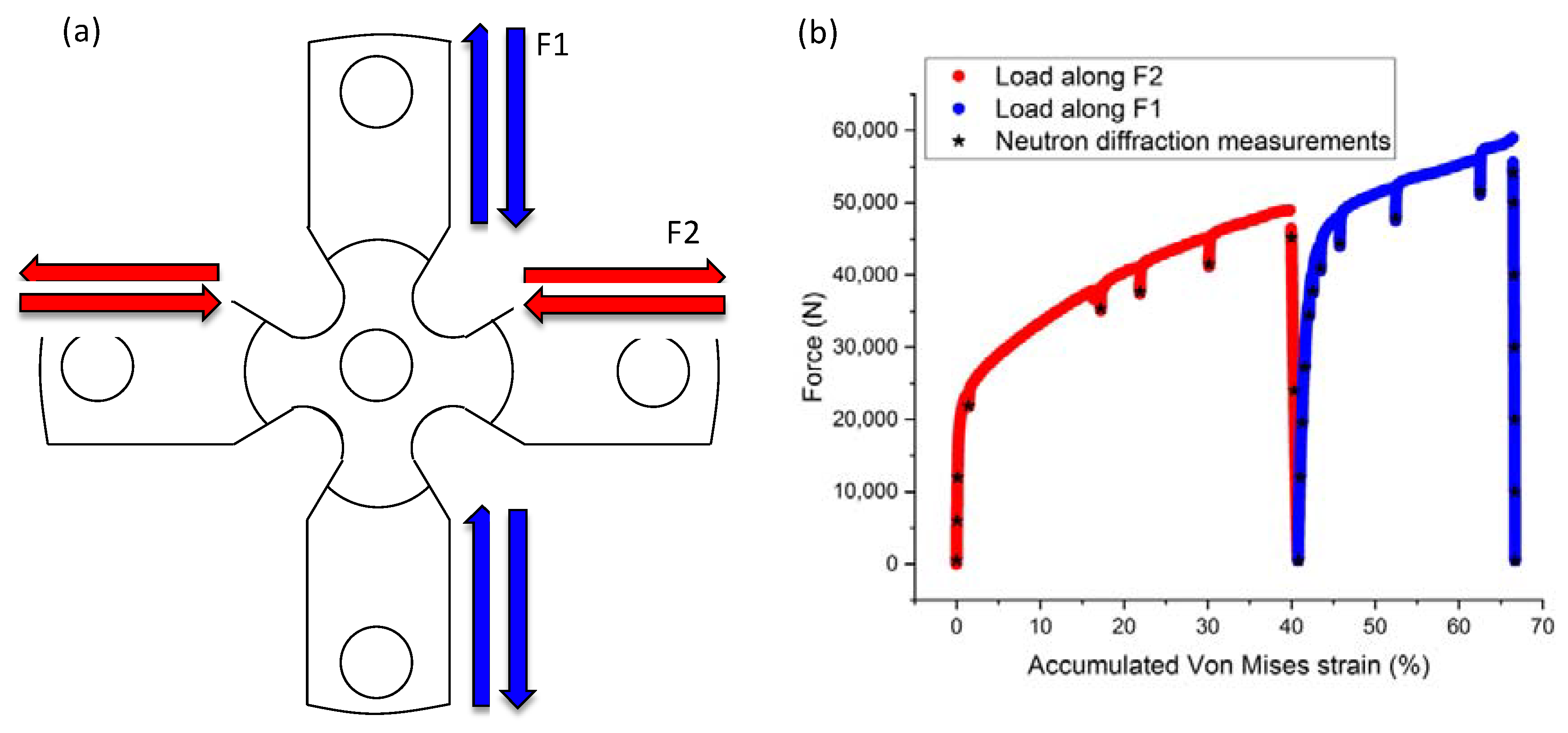
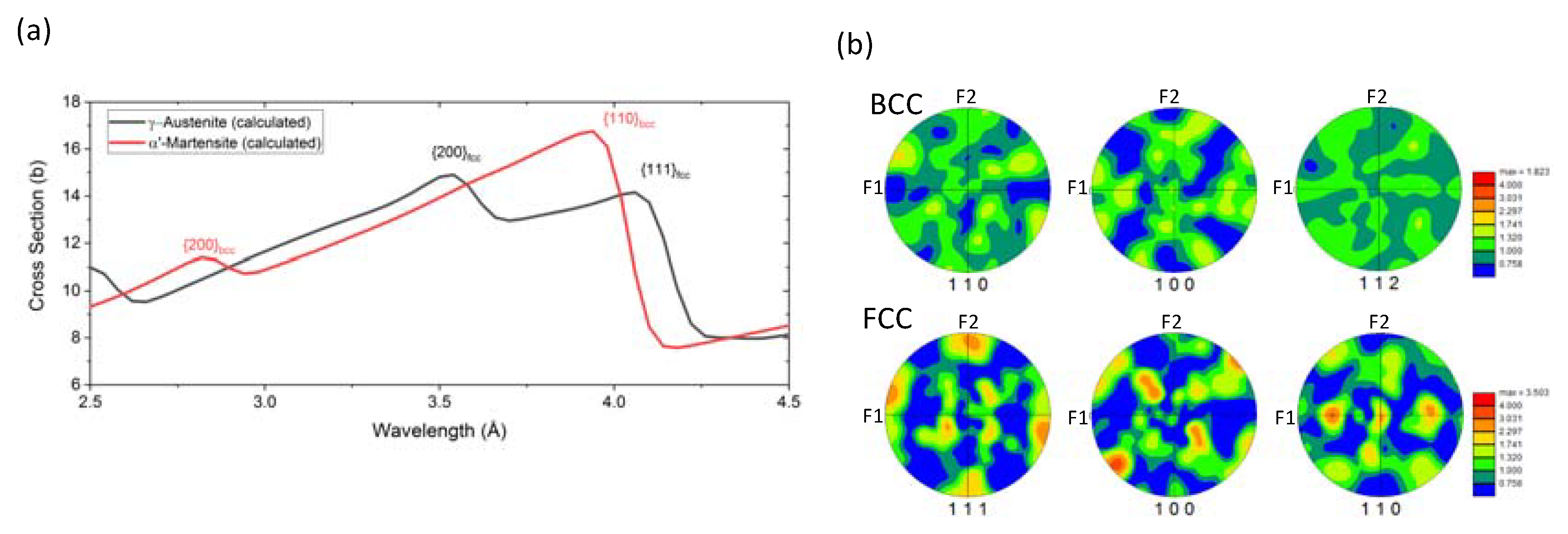


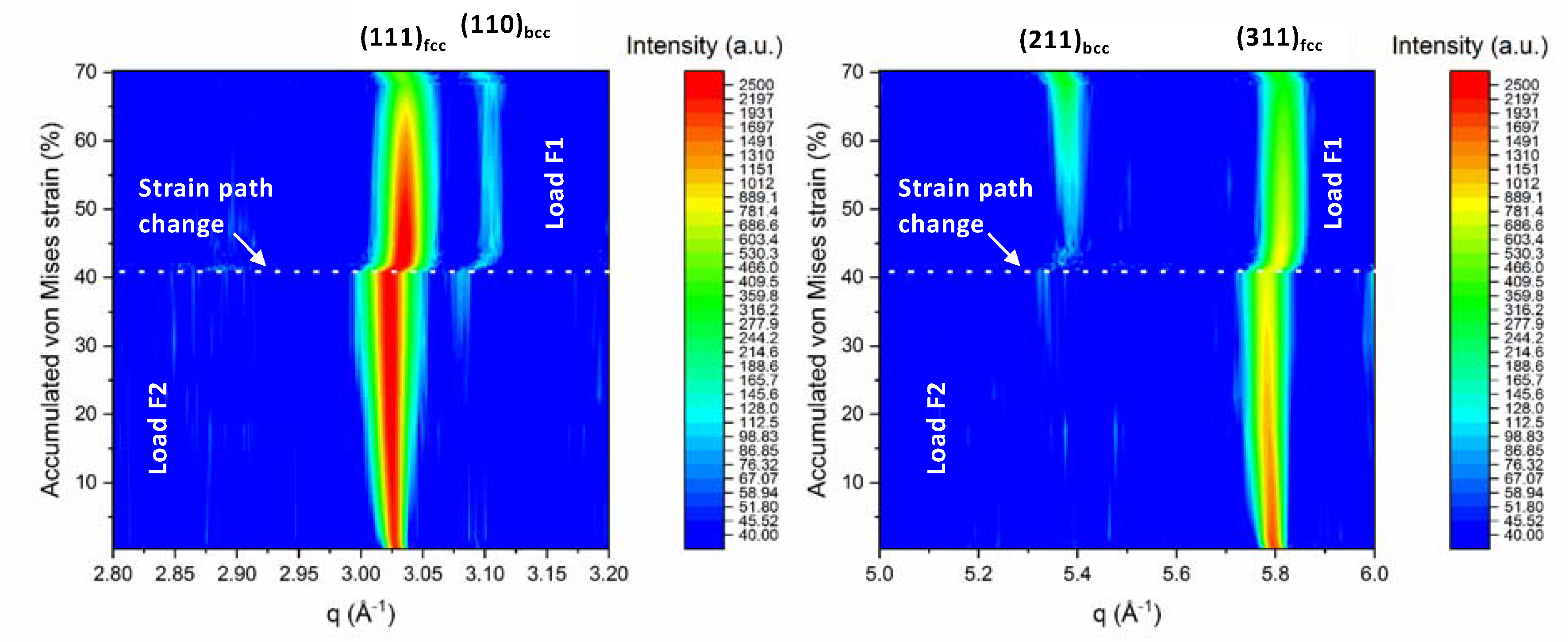
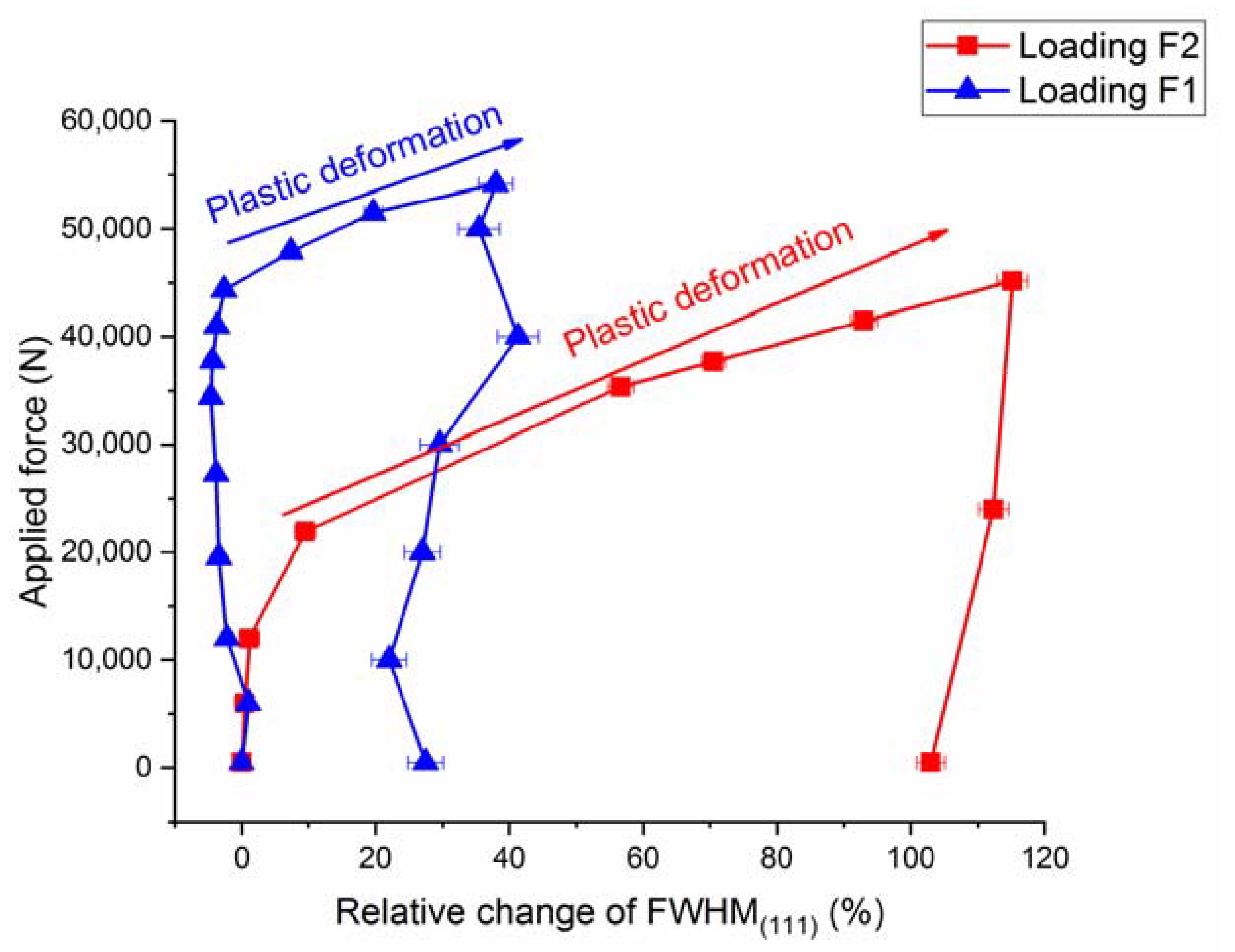
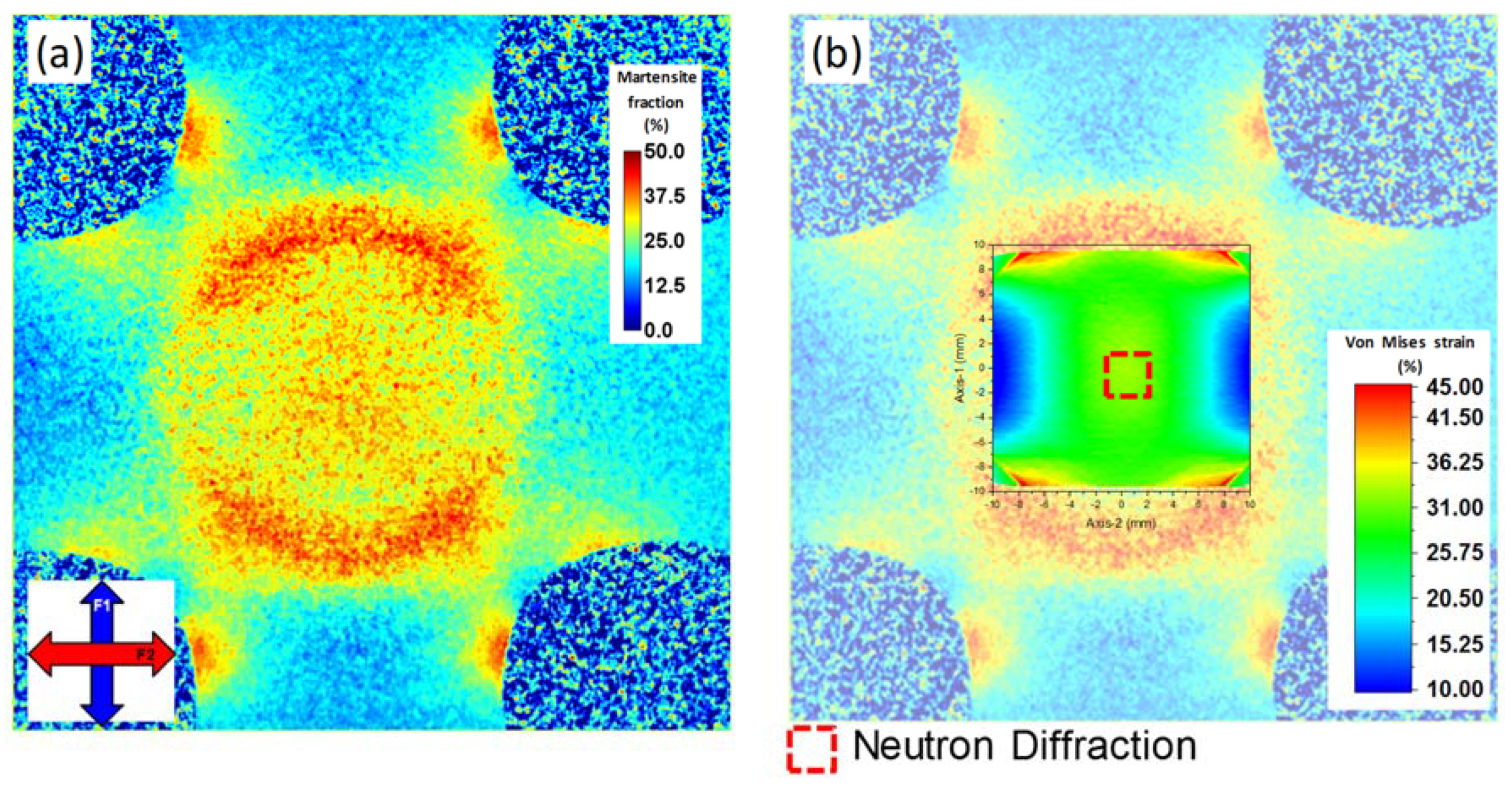
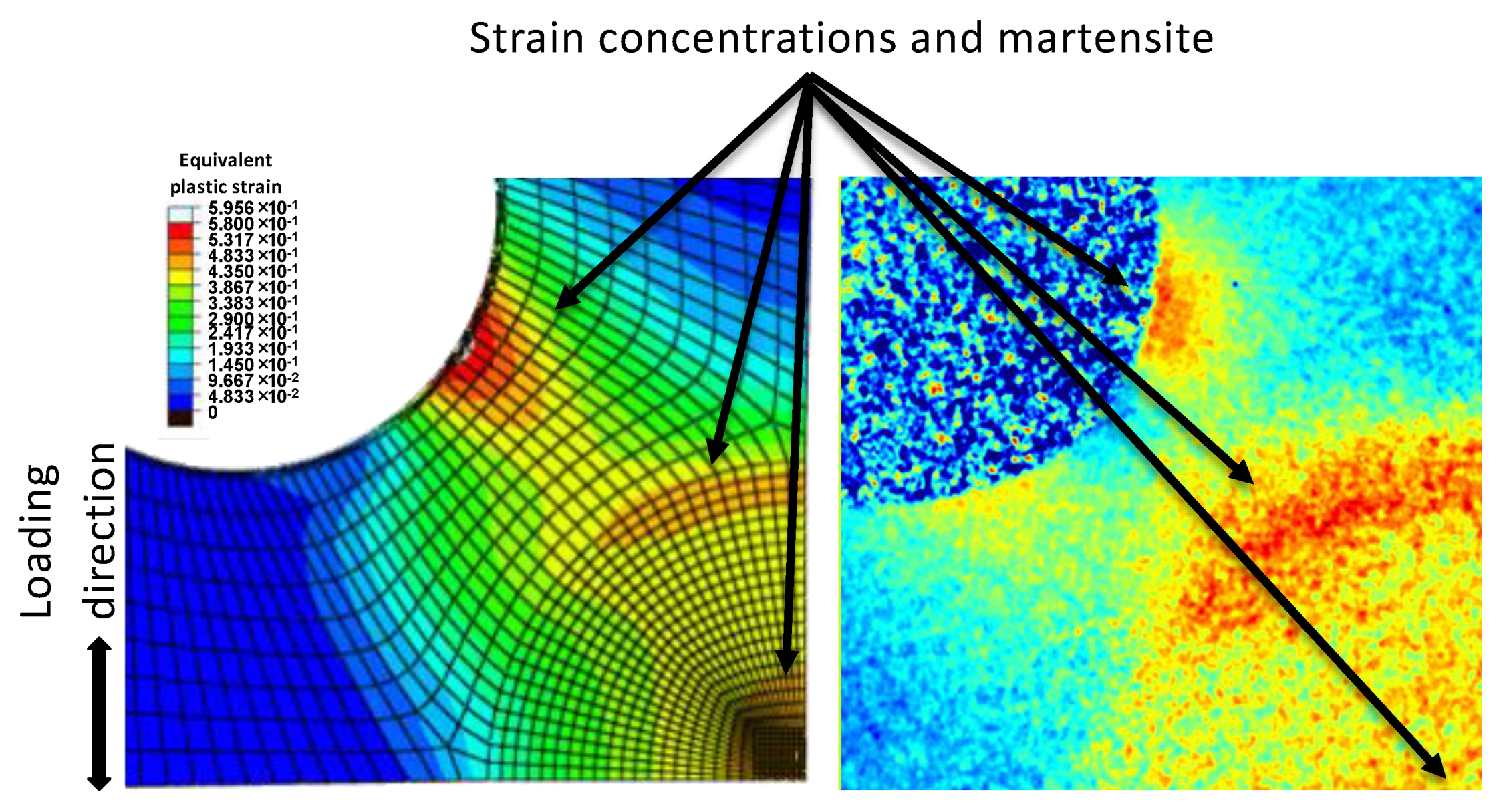
© 2020 by the authors. Licensee MDPI, Basel, Switzerland. This article is an open access article distributed under the terms and conditions of the Creative Commons Attribution (CC BY) license (http://creativecommons.org/licenses/by/4.0/).
Share and Cite
Polatidis, E.; Morgano, M.; Malamud, F.; Bacak, M.; Panzner, T.; Van Swygenhoven, H.; Strobl, M. Neutron Diffraction and Diffraction Contrast Imaging for Mapping the TRIP Effect under Load Path Change. Materials 2020, 13, 1450. https://doi.org/10.3390/ma13061450
Polatidis E, Morgano M, Malamud F, Bacak M, Panzner T, Van Swygenhoven H, Strobl M. Neutron Diffraction and Diffraction Contrast Imaging for Mapping the TRIP Effect under Load Path Change. Materials. 2020; 13(6):1450. https://doi.org/10.3390/ma13061450
Chicago/Turabian StylePolatidis, Efthymios, Manuel Morgano, Florencia Malamud, Michael Bacak, Tobias Panzner, Helena Van Swygenhoven, and Markus Strobl. 2020. "Neutron Diffraction and Diffraction Contrast Imaging for Mapping the TRIP Effect under Load Path Change" Materials 13, no. 6: 1450. https://doi.org/10.3390/ma13061450
APA StylePolatidis, E., Morgano, M., Malamud, F., Bacak, M., Panzner, T., Van Swygenhoven, H., & Strobl, M. (2020). Neutron Diffraction and Diffraction Contrast Imaging for Mapping the TRIP Effect under Load Path Change. Materials, 13(6), 1450. https://doi.org/10.3390/ma13061450






